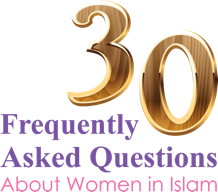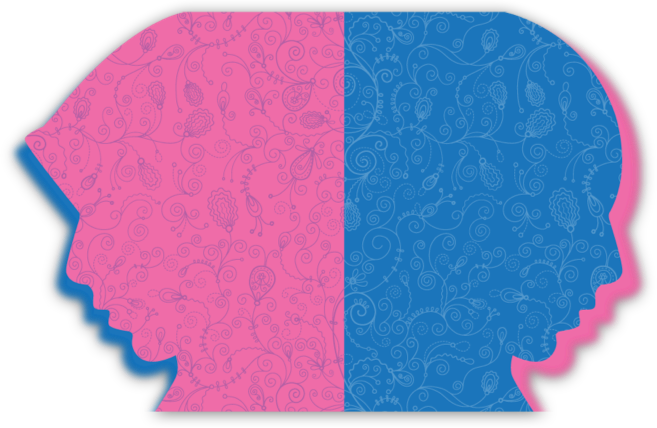

Hijab in Islam
Muslims, men and women alike, are required to dress modestly and control their behavior by lowering their gaze. Women in view of their physical nature are required that in public space they cover their hair and wear an over-garment, (or clothing that does not caricature their bodily form) which is referred as ‘hijab’. The meaning of hijab is to conceal - not revealing or projecting bodily presence. The purpose of hijab is not that women should be absent or invisible in the public domain, but rather they should be present and visible with the power of their bodies switched off. What are the benefits of this? First, most of the time men and women dress to look normal, not to attract one another. But dress normality for men (except for the anxieties of early adolescence) is derived from what other men see normal; women, on the other hand, even when dressing normal only for each other, still evaluate their look among themselves by its appeal to men. Hijab can screen women from that anxiety, at least when in public, of being subject to and evaluated by their sexual gaze. Second, hijab has an educative function. It teaches chastity to the individual who learns by wearing hijab to inhibit the need to be appealing to men; it also teaches the society in which the need to be self-disciplined is signaled and facilitated. Third, hijab publicly and emphatically marks gender differences. It therefore enables women, whilst assuming their active roles in the public domain, to project themselves simply as women without being taken up as objects of desire by men.
Gender in Islam
Men and women are equal before Allah and they have exactly the same religious obligations. However, Islam recognizes the biological and physical differences of the sexes and accordingly accommodates these differences in the practical aspects of life and religious duties. For example, the rights and duties of a husband and a wife in a family are different but they complement each other. Furthermore, Islam cherishes and upholds the woman’s right of the protection of her chastity and honor. Allah says in the Glorious Qur’an; “Verily those who blaspheme unsuspecting chaste believing women will be cursed in this world and the next; and for them there will be severe punishment.”(Qur’an 24:23) In another verse He says, “Those who defame chaste women and do not bring four witnesses should be punished with eighty lashes, and their testimony should not be accepted afterwards, for they are profligates.” (Qur’an 24:4) It is this consideration of gender differences and safeguarding of women’s chastity and honor which defines (a) Islam’s approach to gender dress codes and strict regulations in gender participation in public activities, and (b) Islam’s fierce opposition to the exploitation of women in advertisements, film industry, beauty contests and many other evils. To a non Muslim this approach may be seen as discriminatory to women, but this Muslim approach is in harmony with the natural differences of sexes. No clear minded person would argue that if a man can walk in the street with a bare chest, a woman should also be allowed to do so. Thus Islam is not against women’s freedom but it is against their exploitation by men.
WOMEN ARE THE TWIN HALVES OF MEN
Since its early days, Islam has practically lived its principle of equality between men and women has manifested in the many prominent positions women assumed in the Islamic history and the contributions they have made in the society and development. In our modern times in the Muslim world there have been no less than four female Heads of State. Muslim women serve as Cabinet Ministers, MPs, Ambassadors and Advisors. Many more are CEOs, Entrepreneurs, Doctors, Geologists, Engineers, Professors, Writers, Bankers, Financial Experts, HR Specialists, etc.
The story of Islam cannot be told without women – not merely as oblique references to mothers and wives, but specific women like Khadija, Sumayya, Umm Salama, Nusayba, Khawla, Aisha and many others who, from the earliest days of Islam, embodied the Qur’anic message of human equality and the Prophetic teaching that women are the “twin halves of men.” That more is not known about these women is a real disservice to women’s history.
Khadija : When Muhammad received his “annunciation,” the first encounter with the Archangel Gabriel left him terrified. A popular man with many friends to whom he could have gone. Instead, his first thought was to seek the comfort of his wife, Khadija. Dazzled by his experience, Muhammad asked her what will happen to him. Having only known him to be composed and dignified, she responded with remarkable poise and cool, “You uphold family ties. You give to the poor. You endure misfortunes. You honor guests. You help others when misfortunes decreed by heaven descend. Your Lord will never humiliate you.” She then attested that what had come to him was none other than the revelation from God. Thus, the first revert to Islam was a woman, Khadija, who knew Muhammad better than anyone else. The story of their life together is one that transcends culture and time and still reads as a beautiful love story. She was his most steadfast ally, and the year she died is recorded in Muslim history as the Year of Sadness. It was no coincidence that Khadija is the “First Lady” of Islam. She was competent, wealthy, and widowed prior to marrying Muhammad - she established the precedent that virginity and youth are not the sole allurements of women.
Nusayba : When the tribal leaders of Madinah came to pledge their allegiance to Muhammad, four of the fourteen members of that original allegiance were women. One of those women was Nusayba. During the Battle of Uhud, Nusayba was attending the battle like other women, and her intention was to bring water and food to the soldiers, while her husband and two sons fought. But after the Muslim archers disobeyed their orders and began deserting their high ground believing victory was at hand, the tide of the battle changed, and it appeared that Muslim defeat was imminent. When this occurred, Nusayba entered the battle, carrying a sword and shield. The Prophet later said that every direction he turned, he seemed to find Nusayba there, fighting bravely. Nusayba was revered by most senior Companions, who like Caliphs Abu Bakar and Umar, sought her counsel and wisdom.
Aisha : She was the Prophet’s youngest wife and daughter of his friend Abu Bakar, the man who later became the first Caliph. Aisha’s young age is often brought up by those who intend to demonize Prophet’s character. Though there was a considerable age difference between Aisha and the Prophet, but the marriage was not consummated until Aisha had reached the puberty age. There wasn’t at the time, nor is there now, anything inappropriate about this arrangement. Aisha’s youth provided the Muslim community with a scholar who long outlived the Prophet and who narrated over 2,000 hadiths, many of which are central to Islamic teachings and the understanding of the Prophet. In the initial moments of the birth of Islam, the Prophet took comfort in the arms of his wife, Khadija. At the end of his life, a time that mark the end of revelation, we find him again in the arms of his wife, the young Aisha.
Umm Salama : She came from a well-known tribe and because of her beauty, knowledge and wisdom she held an eminent position. She first got married to Abu Salama, who emigrated with her twice, to Abyssinia and Madinah. Her first husband was killed during the Battle of Uhud, and she remarried to the Prophet. In the day of Hudaibiyah, the Prophet commanded his companions to perform their Umrah’s rituals after he concluded the truce with the Makkan Polytheists. However, the companions did not respond well. They thought that the terms of such truce were not in their favor - a kind of oppression to Muslims. The Prophet repeated his command three times without any response. Accordingly, he went to his tent angry and mentioned what had happened to Umm Salama. With her female intuition she said, "O Prophet of God, you can't make these fifteen hundred men do what they don't want. Just do your own duty, which God has imposed on you. Go ahead and perform your own rites yourself in an open place so that everyone can see you." The Prophet realized the sense of this advice. He stepped out of the tent, slaughtered his animal and started shaving his head. As soon as the people saw him, they followed suit.
Khawla : She was the wife of Aws Ibn as-Samit who fought in all battles along with the Prophet. Once Khawla annoyed her husband and out of anger he rejected his wife with the vulgar expression, "be to me like my mother’s back." According to old pagan custom among the Arabs, the husband would be free of conjugal responsibilities, but the wife was not set free to leave husband’s home or to contract a second marriage. Whatever the reason, after so many years of marriage, these words completely devoid Khawla of sensual attraction to Aws. Sympathetic family and friends had no power to override such customs. When Khawla went to the Prophet to complain of this injustice, the Prophet indicated that existing customs remained normative unless God revealed a new ruling. Khawla's appealed to the higher power than social custom and patriarchal authority - to God Himself. It was this occasion that chapter 58 of the Qur’an entitled “She Who Pleaded” was revealed. It begins with these words, “God has indeed heard the statement of the woman who pleads with you concerning her husband, and carries her complaint to God. And God always hears the argument between both sides among you, for God hears and see all things.” On the basis of this revelation, the justice of her plea was recognized, and this iniquitous custom, based as it was on a false set of values, was finally abolished. Much later when Khawla was an old woman, she once blocked Umar’s way to give him advice when one of Umar’s companions who thought she was impudent to the Caliph asked her to stop. Umar said, “Let her speak. Do you know who she is? This is Khawla the one whose plea was heard above the seventh heaven. She above all deserve to be heard out by Umar.”
Sumayya : Little was known about Sumayya before she became a Muslim other than she was a slave. She then married to Yasir Ibn Amir and they had a son, Ammar. All three were among the earliest converts to Islam. When the Prophet began to preach Islam publicly, the result was active persecution of the small Muslim community in Makkah. The first to be targeted were those who did not have tribal protection like Yasir and his family. Often they would tie them and beat them up. Sumayya was finally stabbed to death by Abu Jahl, the Makkan leader, when she refused to renounce her faith - making her the first martyr of Islam. The Prophet was very troubled by the persecution of the Muslims and the murder of Sumayya. He was quoted in a hadith trying to comfort them, “Patience Oh family of Yasir, for you are destined for Paradise.” Sumayya is remembered for her strength, courage, and faith in a period when the Muslims were heavily persecuted. She is important because her active commitment to her faith dispels the image of Muslim women nowadays that they are oppressed.







